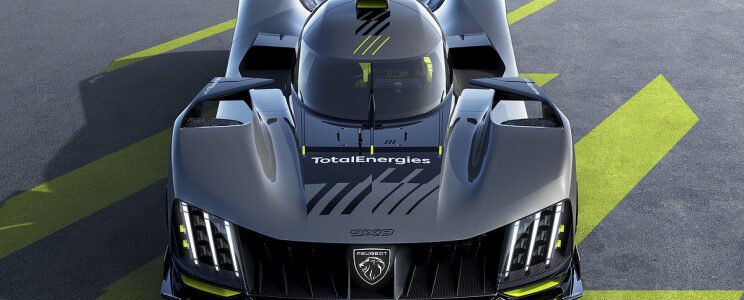Aside from strikingly good looks, what comes to mind first when you think of a hypercar or Formula One? If you answered sleek, aerodynamic styling you’d be right and that usually involves a big rear wing. However, Peugeot’s latest hybrid hypercar doesn’t have a rear wing which many consider a massive achievement.
The Future Of Hypercar Racing
The car segment looks set on going electric and not only for commuting to work, or pickup trucks and SUVs but also hypercars. Ferrari and Lotus have already gone electric and now Peugeot is joining the production hype with a wingless hypercar. Their goal is to enter the hybrid hypercar into the 2022 FIA World Endurance Championship and the 24 Hours Le Mans in 2022.
With rising costs of entering the Le Mans Prototype 1, the Fédération Internationale de l’Automobile (FIA) created the Le Mans Hypercar class. They wanted to grab more attention without breaking the bank for carmakers. The FIA has provided a set of rules for car designs and then tests them for reliability and efficiency at the Le Mans circuit.
This annual 3,000-mile (5,400 kilometres) long race must be completed in 24 hours which many regard as the ultimate test of endurance for any car.
Unwrapping The New 9X8 Hybrid Hypercar
Peugeot’s latest endurance racer is a direct successor to the Peugeot 905 that won the Le Mans 24 Hours in 1992 and 1993 as well as the Peugeot 908 which won the French classic in 2009. The new prototype hypercar looks set on continuing the brand’s long and successful involvement in world-class motorsport competing with big racing brands.
The Peugeot 9X8 project is in accordance with the carmaker’s Neo-Performance vision founded on combining premium sporting pedigree with styling excellence, efficiency and technological expertise. Peugeot wants this sort of innovation to carry over to road cars which may lead to some fascinating results.
This comes from an unprecedented collaboration between Peugeot’s design and engineering teams and Peugeot Sport. Together, they want to create a completely original product line by exploring new aerodynamic solutions and styling ideas.
Styling Of The 9X8 Hypercar

The front and rear lighting signatures take the form of three claw-like strokes which are familiar trademarks. Peugeot’s new lion’s head logo features prominently in the backlit form at the front and on the sides of the car. The body kit looks phenomenal with selenium grey and contrasting kryptonite acid green/yellow highlighting the body and inside the cockpit.
When it came to the interior, they wanted to take a special approach to the cockpit and for good reason. Until now, it’s been a purely functional and indistinctive aspect of racing cars with no brand identity. The combination of colour and Peugeot’s i-Cockpit interior styling signature have given the 9X8 a much more distinctive feel.
On the outside, the sculpted wheels contribute to balanced lines of the car’s sleek, simplistic but stylish flanks. The wing vents reveal the top of the tyres and the perfectly integrated mirrors help the airflow pass over the car unimpeded.
Why Go Wingless?
Rear wings on the Chaparral 2F were first questioned at the Le Mans 24 Hours in 1967 and now, it’s not even fitted to the 9X8. This is thanks to Peugeot’s innovative rear stems which come from extensive research carried out by the engineering team.
After deciding to compete in the 2022 event, Peugeot started designing their hypercar but with a twist. They wanted to break the stereotype of what a racing car should be and created something truly spectacular.
The regulations permitted only one adjustable aerodynamic feature so they removed the rear wing to deliver high performance. This allowed them to design a streamlined hypercar that not only looks impressive but also packs a punch.
Recommended: ‘Current and New Automotive Manufacturing Technologies’
How Efficient Is The Hybrid Powertrain?
This hypercar has a rear-mounted engine pushing out 500kW (680hp) from its 2.6-litre, bi-turbo, 90-degree V6. Meanwhile, the front-mounted 200kW motor-generator unit, seven-speed sequential gearbox and battery are being assembled to meet the bench-testing validation schedule. Peugeot Sport and Saft, a subsidiary of TotalEnergies, are co-developing the powerful, technologically sophisticated, high-voltage, high-density battery.
In addition to its aerodynamic, mechanical and electronic efficiency, the new hypercar will be a showcase of the French automaker’s extensive engineering expertise in the ever-evolving and challenging world of endurance racing.
Stellantis Motorsport Director Jean-Marc FINOT said: “The absence of a rear wing on the PEUGEOT 9X8 is a major innovative step. We have achieved a degree of aerodynamic efficiency that allows us to do away with this feature. Don’t ask how, though! We have every intention of keeping that a secret as long as we possibly can!”
Thoughts On The 9X8
In the words of Peugeot’s CEO Linda JACKSON: “I know the teams at PEUGEOT Design and PEUGEOT Sport and they always produce quality, innovative work, but I have to admit to being blown away by the 9X8. It is simply magnificent. The way its innovative, flowing lines exude such a powerful brand identity is masterful.”
Kevin Magnussen, a former Formula 1 driver and IMSA endurance racing driver said: “There’s been nothing like it before. It really looks like the future of racing. It’s the first time so much work has gone into a racing car’s actual design. The absence of a rear wing was a huge surprise. It feels like the beginning of a new era.”
For more interesting articles on technology, engineering and manufacturing, please visit the website. Our topics cover various sectors including automotive, aerospace, defence, rail and construction among others.


Recent Comments